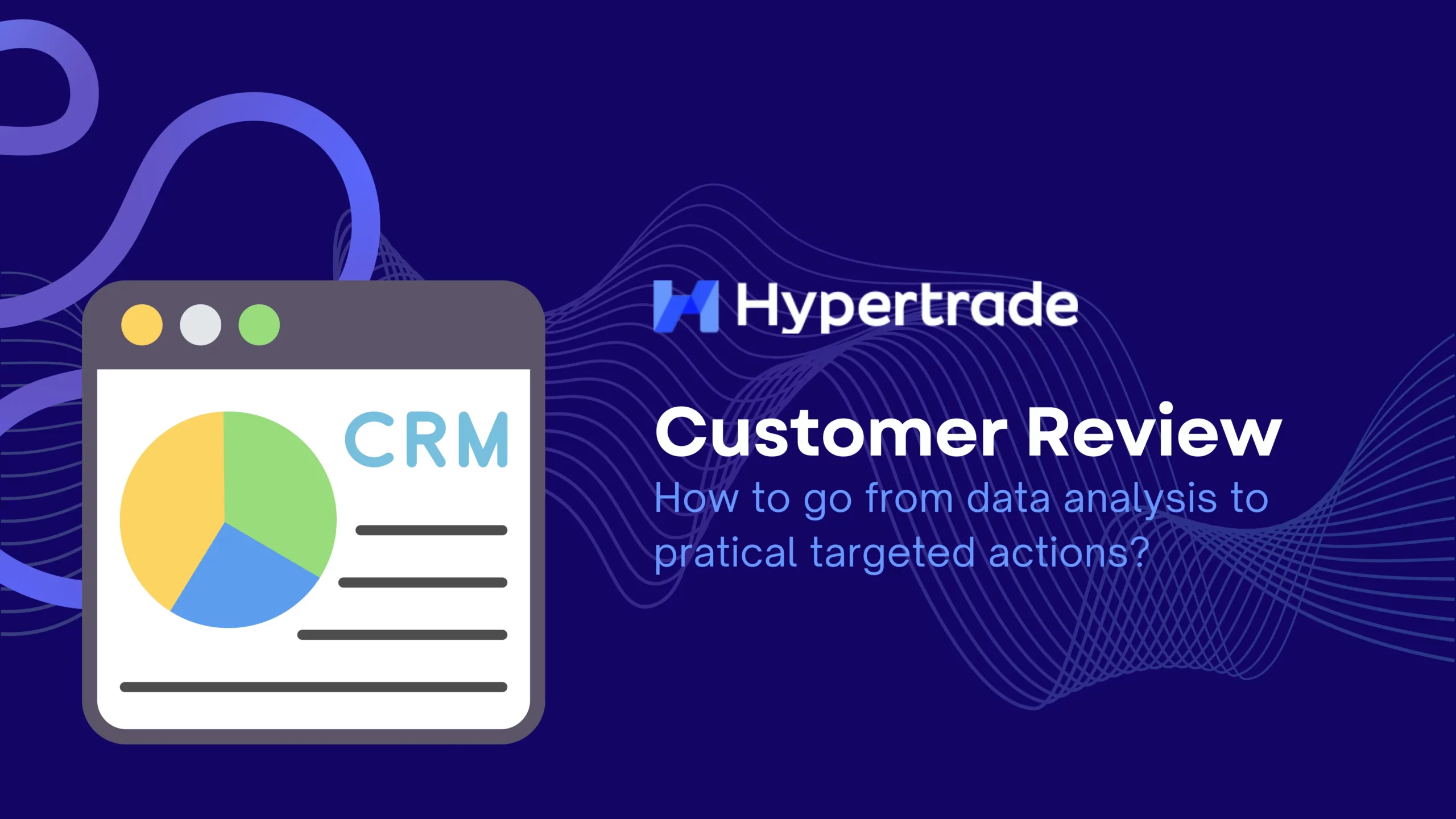Customer Reviews are critical. They mix discovery, analyses and action. They require a methodological approach to simplify it and deliver practical and actionable recommendations.
As we regularly do Category Reviews or Brand Reviews, it has become also necessary to perform regular Customer Reviews. Such Customer Reviews can be automated with Ulys CRM. The key objectives of the Customer Reviews are to:
Understand Customer Behavior: Insights gained from understanding customer behavior (such as specific segments’ preferences or spending patterns) inform the need for targeted actions. This is where you determine which segments require intervention or which product categories need promotion.
Improve Retention and Engagement: The actionable strategies you develop (e.g., promotions to increase basket sizes or campaigns to highlight neglected products) are directly aimed at improving customer retention and engagement. This objective focuses on implementing changes to enhance customer loyalty.
Identify the actions required: Translating insights into actions involves tailoring offers, targeting offers refining reward structures, and improving messaging based on the insights you’ve gathered.
The Customer Review evolves in a multi-format and sales channels environment, across several Customers segment and delivers recommendations that involve both Marketing and Category Management teams. A structured and methodological approach, which we are sharing below, helps simplify its complexity and deliver practical and actionable recommendations.
The Customer Review structure can follow a 4 steps transversal approach across Customer Segments, Sales Channels (formats) and Categories with action in Mind.

Let’s now review each step and how to find actionable insights that will strengthen your Customer retention, engagement and sales!
1. Customer Segments Analysis
The objectives of the Customer Segments analyses are to understand which segments need attention in which sales channel or format.
It is a good idea to start the Customer Segment Analysis by reviewing the performance of different customer segments. Look at metrics such as purchase frequency, average basket size, and overall engagement.
This analysis can lead to identifying Behavioral Insights and Trends. For segments that show issues or opportunities, we will dive deeper into their interactions with different product categories. This might involve analyzing category-specific purchase patterns, preferences, and trends.
The next step should bring us to understand how Retention works. Based on your findings, you can create tailored strategies for each segment. For example, if a segment is underperforming in a certain format or channel, you might implement targeted promotions or special offers to boost engagement with that category on the most impactful segment.1
The next component to analyse should be the Acquisition. Not only do we want to identify the growth of loyal shoppers, but we also want to measure the evolution of the acquisition costs, as well as understanding what strategies work well and which ones don’t.
Engagement must also be measured. The way engagement is measured depends on each company and can be as simple as it can be complex2. Online channels have their own metrics that can be automatically accessed through Google or Microsoft tools. Other metrics like repeat purchase, Customer Lifetime Value, Churn or campaigns transformation rate as well Customer Satisfaction Surveys or Net Promoter Scores can be considered.
The matrix below summarizes how this Customer Segment Review can be simply doner
Unable to load the picture
(evol: evolution vs. last month │Trend: trend over the last 6 months)
The prioritization of the action will be based on the sales weight of each channel and, inside a channel, the sales weight of each KPI.
The type of action that can be decided will usually be targeted campaigns based on the KPI to be primarily activated in the selected sales channel for the selected customer segment group3
2. Category Analyses from A Shopper Perspective
The Customer analysis for your Strategic Categories explains what is not on par with your plans and delivers recommendations that are specific to selected customer segments in specific categories.
The Category analysis will mix 3 dimensions: Categories4, sales channel and shopper behaviors. In addition to the Shopper behavior Metrics used in the Customer Segment Analysis, for each category, the Sales Contribution and Sales growth, Penetration and Share of Wallet will be added to have a better understanding of the behaviors within the category.
The analysis matrix is described below:
Unable to load the picture
To prioritize the actions, it is recommended to setup
- a simple Overall Category Scoring Index to select the most important categories to work on
- a simple Lever Priority Index to select the right KPI to focus on for the selected categories
- A simple visualization aid so Teams can quickly decide which category to activate and which lever to stimulate.
The type of action that can be decided will usually be targeted campaigns based on the KPI to be primarily activated in the selected sales channel for the selected category and Shopper behavior.
3. Combining Customer Segments & Categories Perspectives for Actions
Combining manually the 2 perspectives and prioritizing the right categories (the one with the biggest impact on sales) and the right customer behavior lever (the one that will have the biggest influence on sales) can be a daunting task.
To make this simple and lead to a quick focus on action, the heatmap concept is very useful. This heat map is built with the Overall Category Scoring Index, the Level Priority Index and an Impact Score Index. The Impact Score Index estimates the sales increase impact for each lever.
Unable to load the picture
What the Marketing team must now work on is a heatmap as shown on the left.
4. Mapping the right Action with the right Symptom
There are obviously no absolute rules for this mapping. In the table below, we have tried to provide meaningful examples
| Metric | Definition | Dimension | Analysis Focus | Action | Examples5 |
| Shopper Frequency | Number of visits of a customer over a specific period | Channels Formats Customer Segments | Trends in customers engagement Cross channels & formats comparison Cross Segments comparison | Increase shopping frequency Address specific declining formats, channels or segments | % discount or Points when shop certain number of times over a period Stamp Cards |
| Basket $ | Average amount spent by customers per visit | Channels Formats Customer Segments | Assess High Value customers across Segments Identify categories where the spending decrease most | Optimize products and pricing Target promotions on concerned segments | % discount or rewards over a certain amount of spending Next best offers to enlarge shoppers’ choice |
| Nbr. Items per basket | Average number of items purchased by transaction | Channels Formats Customer Segments | Assess cross-selling and up-selling Identify categories where the spending decrease most | Increase promotion bundling Review Assortment to encourage higher purchase volumes | Buy X get Y promotions Target Next best offers to enlarge shoppers’ choice |
| Penetration | Percentage of customers purchasing from a category | Channels Formats Customer Segment | Identify what has changed in the concerned categories6 | Drive Traffic to the category | Special discount on the category New Items information |
| Share of Wallet | Proportion of Customer spent allocated to a category | Channels Formats Customer Segment | Analyze the evolution of each categories weight as per shoppers’ preferences by segment Prioritize high share categories in resources allocations | Increase share of wallet by increasing categories’ value proposition | % discount or rewards over a certain amount of spending Products bundling or cross-selling Personalized recommendations |
| Category / Brand Frequency | Number times customers purchase from a specific category over a period | Channels Formats Customer Segment | Identify categories that drives shopping frequency Track promotions performances | Boost repeat purchase with targeted category promotions Expand successful categories to other format or channels | % discount or rewards over a certain number of repeat purchases Rewards next purchase in the category |
| Retention | Ratio of customer that repeat purchase over time | Channels Formats Customer Segment | Assess loyalty and engagement over time Identify factors affecting retention | Enhance loyalty program based on retention insights | Tiered Loyalty Anniversary rewards Behavior based rewards (referrals, Exclusive offers |
5. Selecting the Right Products
When you setup a promotion, targeted or not, personalized or not, you are basically targeting 1 of these 3 objectives:
- Increase Purchase Frequency: Encourage existing customers to buy more of a product they’ve already purchased. This could involve offering a quantity discount or bundling it with complementary products.
- Expand Product Range Within Category: Promote related or complementary products within the same category. For instance, if a customer frequently buys coffee beans, you might suggest a coffee grinder or a new flavor.
- Cross-Sell to New Categories: Introduce products from different categories that the customer might be interested in based on their purchasing history or preferences. For example, if a customer often buys running shoes, you could suggest sports nutrition supplements.
To increase the purchase Frequency, usual selection key will be, within the customer segment:
- Increase Purchase Frequency: Top selling item, Top Promoted Items, Top penetration items or Top products with a selected mechanics
- Expand Product Range Within Category: same item selection key but for the sub-categories or brand that the cross-selling analyses recommend. An advanced approach can use a next best offer algorithm within the category
- Cross-Sell to New Categories: same item selection key but for the sub-categories or brand that the cross-selling analyses recommend. An advanced approach can use a next best offer algorithm a group of categories
By Following this approach, you can develop and product automatic Customer Reviews with practical data-driven recommendations and follow their performances once executed.

Contact us to turn your Customer Data into actionable insights that drive retention and basket size.
contact@hyper-trade.com







